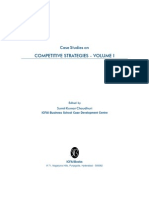Summary of What Is Strategy HBR Article
Summary of What Is Strategy HBR Article
Uploaded by
Yamini PatarCopyright:
Available Formats
Summary of What Is Strategy HBR Article
Summary of What Is Strategy HBR Article
Uploaded by
Yamini PatarOriginal Title
Copyright
Available Formats
Share this document
Did you find this document useful?
Is this content inappropriate?
Copyright:
Available Formats
Summary of What Is Strategy HBR Article
Summary of What Is Strategy HBR Article
Uploaded by
Yamini PatarCopyright:
Available Formats
Summary of “What is Strategy?
” by Michael Porter, HBR article
Rivals can easily copy your improvements in quality and efficiency. But they shouldn’t
be able to copy your strategic positioning—what distinguishes your company from all the
rest.
The myriad activities that go into creating, producing, selling, and delivering a product or
service are the basic units of competitive advantage. Operational effectiveness means
performing these activities better—that is, faster, or with fewer inputs and defects—than
rivals. But from a competitive standpoint, the problem with operational effectiveness is
that best practices are easily copied.
Strategic positioning attempts to achieve sustainable competitive advantage by
preserving what is distinctive about a company. It means performing different activities
from rivals, or performing similar activities in different ways.
Three key principles underlie strategic positioning.
1. Strategy is the creation of a unique and valuable position, involving a different set of
activities. Strategic position emerges from three distinct sources:
2. Strategy requires you to make trade-offs in competing—to choose what not to do.
3. Strategy involves creating “fit” among a company’s activities. Fit has to do with the
ways a company’s activities interact and reinforce one another.
Employees need guidance about how to deepen a strategic position rather than broaden or
compromise it. About how to extend the company’s uniqueness while strengthening the
fit among its activities. This work of deciding which target group of customers and needs
to serve requires discipline, the ability to set limits, and forthright communication.
Clearly, strategy and leadership are inextricably linked.
You might also like
- Final Presentation - AccountingDocument41 pagesFinal Presentation - AccountingViễn Nguyễn KýNo ratings yet
- GloBus Midterm ReviewDocument18 pagesGloBus Midterm ReviewMatthew StojkovNo ratings yet
- Free Excel Student Template October 20141Document140 pagesFree Excel Student Template October 20141Sthephany Granados0% (1)
- Summary For PorterDocument3 pagesSummary For PorterAbed AbedNo ratings yet
- Strategic Management Exam JaimeDocument21 pagesStrategic Management Exam JaimeScribdTranslationsNo ratings yet
- Finding The Right Job For Your ProductDocument2 pagesFinding The Right Job For Your ProductRaviTejaPR0% (1)
- PHT and KooistraDocument4 pagesPHT and KooistraNilesh PrajapatiNo ratings yet
- Strategic ManagementDocument4 pagesStrategic ManagementA CNo ratings yet
- Summary - Looking Inside For Competitive AdvantageDocument2 pagesSummary - Looking Inside For Competitive AdvantageShabrina Wulan NursitaNo ratings yet
- Creating Corporate AdvantageDocument3 pagesCreating Corporate AdvantagePrathameshNarkarNo ratings yet
- Section A: Read The Following Case Carefully and Answer ALL The Questions That FollowDocument3 pagesSection A: Read The Following Case Carefully and Answer ALL The Questions That Followsamuel_dwumfourNo ratings yet
- Strategy and Competitive Advantage in Diversified CompaniesDocument61 pagesStrategy and Competitive Advantage in Diversified CompaniesAnum ImranNo ratings yet
- Strategy ManagementDocument10 pagesStrategy ManagementSibin PiptiNo ratings yet
- Mapping Your Innovation Strategy: Case Study CritiqueDocument5 pagesMapping Your Innovation Strategy: Case Study CritiqueHanan SalmanNo ratings yet
- Market SizeDocument4 pagesMarket SizepichhibabuNo ratings yet
- CPM - StrategyDocument6 pagesCPM - Strategyhoopyfrood24No ratings yet
- Chapter 2 SummaryDocument3 pagesChapter 2 SummaryeudamnboredNo ratings yet
- Management 595 - Fall 2019 Exam 1 Study Guide: A. Essay QuestionsDocument8 pagesManagement 595 - Fall 2019 Exam 1 Study Guide: A. Essay QuestionsmeghanNo ratings yet
- Vera Bradley in 2014Document9 pagesVera Bradley in 2014Adrian BenczeNo ratings yet
- Whirlpool Management StrategyDocument5 pagesWhirlpool Management StrategynimrawadoodNo ratings yet
- Assessment Point - The Reflective EssayDocument15 pagesAssessment Point - The Reflective EssayRue Spargo ChikwakwataNo ratings yet
- F Unilever's GCSDocument6 pagesF Unilever's GCSMehedi HasanNo ratings yet
- Grand StrategiesDocument8 pagesGrand StrategiesGautam Krishna50% (2)
- Breadtalk KimEngDocument29 pagesBreadtalk KimEngCipto WibowoNo ratings yet
- Caux Principles 1Document4 pagesCaux Principles 1Kirti DadheechNo ratings yet
- Methods of Financial Statement AnalysisDocument2 pagesMethods of Financial Statement AnalysisAnonymous PjIuBB0% (1)
- Hierarchical Levels of StrategyDocument5 pagesHierarchical Levels of StrategyAjay RawatNo ratings yet
- Case Studies On Competitive Strategies - Vol. IDocument7 pagesCase Studies On Competitive Strategies - Vol. Iibscdc100% (1)
- Cost Leadership, Differentiation and Niche Strategies AssignmentDocument19 pagesCost Leadership, Differentiation and Niche Strategies AssignmentDoris AchengNo ratings yet
- Chapter 13 - Managing CommunicationDocument28 pagesChapter 13 - Managing CommunicationSelena ReidNo ratings yet
- Advanced Operations Management AssignmentDocument3 pagesAdvanced Operations Management AssignmentTop Engineering SolutionsNo ratings yet
- Building Brand Reputation Through Marketing Mix - A Case Study On AARONGDocument15 pagesBuilding Brand Reputation Through Marketing Mix - A Case Study On AARONGUzzal Sarker - উজ্জ্বল সরকারNo ratings yet
- Business Strategy Mid Term Short AnswersDocument4 pagesBusiness Strategy Mid Term Short AnswersMonil ChhedaNo ratings yet
- Lesson No. 13 - Ethics and Social Responsibility in ManagementDocument25 pagesLesson No. 13 - Ethics and Social Responsibility in Managementjun junNo ratings yet
- Case Harvard Coach KnightDocument3 pagesCase Harvard Coach KnightKhawaja Arsalan100% (1)
- BCG and GEDocument19 pagesBCG and GEReshma GoudaNo ratings yet
- Case Study Sample Questions Answers On CSR ADMS 1000Document2 pagesCase Study Sample Questions Answers On CSR ADMS 1000julia brossardNo ratings yet
- Marketing Management AssignmentDocument12 pagesMarketing Management AssignmentVineet Ganvi100% (1)
- Porter Generic StrategiesDocument3 pagesPorter Generic StrategiesbravehorseNo ratings yet
- Management Strategic For External AssessmentDocument40 pagesManagement Strategic For External AssessmentRadhika Hartami PutriNo ratings yet
- CostcoDocument7 pagesCostcoAbeer arifNo ratings yet
- Strategic Management CH 08Document13 pagesStrategic Management CH 08Khadra NuurNo ratings yet
- Aleena Amir EM Quiz 7Document3 pagesAleena Amir EM Quiz 7Aleena AmirNo ratings yet
- Diversification in The Context of Growth StrategiesDocument10 pagesDiversification in The Context of Growth StrategieskavenNo ratings yet
- MKT Marketing ch-2Document21 pagesMKT Marketing ch-2Sharif HossinNo ratings yet
- 1410ict - Draft eDocument10 pages1410ict - Draft eDhyllan Rhys McEnroeNo ratings yet
- The Barriers To Entry and ExitDocument3 pagesThe Barriers To Entry and ExitRashed SifatNo ratings yet
- Five Forces Model of Airline Industry - Essays - RavindercaDocument1 pageFive Forces Model of Airline Industry - Essays - RavindercaAnk's Singh100% (1)
- Strategic Management Assignment 3Document14 pagesStrategic Management Assignment 3Djimajor Robert TettehNo ratings yet
- Entreprenuership AssignmentDocument15 pagesEntreprenuership AssignmentBhavyata VermaNo ratings yet
- The Parenting Matrix Sum UpDocument2 pagesThe Parenting Matrix Sum Upilikesummer1234No ratings yet
- Barriers To EntryDocument6 pagesBarriers To EntryJamila HidalgoNo ratings yet
- Case: Riyadh SportsDocument4 pagesCase: Riyadh SportslackylukNo ratings yet
- Annual Report - FinalDocument25 pagesAnnual Report - Finalapi-460344150No ratings yet
- Guidelines To Listing On The JSEDocument12 pagesGuidelines To Listing On The JSEJustin CorbettNo ratings yet
- Strategic MGT MidtermDocument15 pagesStrategic MGT MidtermFayaz ThaheemNo ratings yet
- Value Chain Management Capability A Complete Guide - 2020 EditionFrom EverandValue Chain Management Capability A Complete Guide - 2020 EditionNo ratings yet
- Growth Strategy Process Flow A Complete Guide - 2020 EditionFrom EverandGrowth Strategy Process Flow A Complete Guide - 2020 EditionNo ratings yet
- Critical Equipment and Technologies Developed by DRDO For Combating COVID-19 Pandemic 09/06/2020Document76 pagesCritical Equipment and Technologies Developed by DRDO For Combating COVID-19 Pandemic 09/06/2020Yamini PatarNo ratings yet
- Us4832942 PDFDocument6 pagesUs4832942 PDFYamini PatarNo ratings yet
- TI Cycle: New Product Development StrategyDocument18 pagesTI Cycle: New Product Development StrategyYamini PatarNo ratings yet
- IJMH050304Document5 pagesIJMH050304Yamini PatarNo ratings yet































































